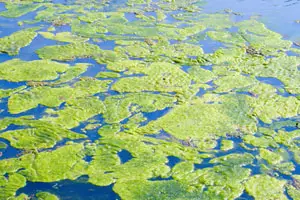Pond algae is inevitable. These single-celled plants are very hardy and, once many of them form a colony, they turn the pond's surface into an ugly green mess. There are, however, some beneficial types of koi pond algae that one actually should be happy to see sprouting up. The question is: How does one eliminate the bad algae and keep the good algae in the pond? The answer is quite complex.
Competitors

Algae, like all plants, needs nutrients and light to survive. It can be outcompeted for these resources by other plants. One of the most effective, and most beautiful, ways to combat algae is to add floating plants to the surface of the pond. Plants such as Duckweed and Water Hyacinth are excellent ways to deprive it of the light it needs to flourish. At the same time, these plants provide the fish with shelter and roots in which they like to breed.
Any plant will eliminate some nutrients from the water and prevent algae from taking hold. Make certain to incorporate plants into one's plans.
Circulation
Algae loves stagnant water. To that end, one should keep their water constantly circulating to ensure that many types of undesirable algae have no place to grow. A pond pump should circulate about 50 percent of the water per hour. For a koi pond, the entire volume of the water should be circulated every hour. If this circulation is not maintained, the water will quickly fill-up with algae and the environment will become very unhealthy for the fish.
Filtration
There are several different types of filters on the market. All of them can help combat algae in various ways. The two types most associated with fighting pond algae are UV filters and biological filters.
UV Filters
Ultraviolet light is a powerful biocide. In fact, ultraviolet light is among the ways in which hospital instruments are sterilized. To ensure that one's water remains as algae-free as possible, ultraviolet light is a great resource.
Ultraviolet light provides algae control by actually destroying the DNA in the algae's cells. A small amount of water is passed through the filter at a time and is exposed to intense ultraviolet light. This destroys the DNA in the same fashion as ultraviolet light from the sun destroys the DNA in human skin tissue. Don't worry about getting cancer from the filter, however, the UV from the sun is orders of magnitude more powerful than that emitted by the pond UV filter.
These filters can take a long time to work but they can provide excellent results. They are among the single best ways to eliminate it from one's pond. Best of all, they don't eliminate the beneficial algae that grows along the liner and which provides a snack for the fish!
Biological Filters
Biological filters use single-celled organisms to consume and outcompete the algae in a pond. These are another very effective way to keep this nuisance plant at bay. These filters may take months to make a difference but they're well worth the wait. Once the filter has balanced the water against the growth of algae, the results are spectacular.
Remember that these filters must run at all times to ensure a clean pond. Be patient and, sooner or later, the difference will be remarkable. These filters need to be cleaned from time to time and need to have their supply of beneficial bacteria replenished. One needs to do so according to the manufacturer's directions for the device in question.
Elbow Grease
Some algae can be removed from the pond physically. On features such as waterfalls and fountains, one may see long strings of green algae take hold. One can simply pull and scrub this away with the hands. Be certain not to confuse this algae with the "furry" type of algae found just about everywhere in the pond. The latter type is of great benefit to the pond's ecosystem.
The algae that collects in mats on the surface of the water can be removed with a simple net. This should be done as soon as it is noticed. These mats are just free-floating colonies of algae and are easily enough skimmed off the surface.
A mechanical water skimmer makes this work a bit easier. These devices are a type of filter that pulls water in from the surface of the pond and filters out debris and other pollutants such as algae mats. Every pond should have one of these installed.
Fish pond algae is generally at its worst when the pond is first installed. This is because the tiny ecosystem hasn't quite balanced out and the algae will have several ecological niches in which it can establish itself. As the plants become more developed, the filters fill the water with algae-fighting bacteria and the UV filter is given time to work, the fish pond will become clearer and clearer.
There is a caveat where algae in ponds is concerned: Clear water does not necessarily mean healthy water. One may look at their crystal-clear pond and feel that all is right with the world without realizing that the water is filled with nutrient-draining pond algae and harmful bacteria. Leave the biological filter on at all times and make sure that one purchases the correct UV filter for the job. Ideally, look for a UV filter that is advertised as a "sterilizer" rather than a "clarifier".
Algae control, as one can see, is a significant effort. However, once one gets the ball rolling and once the pond becomes more established, the effort becomes much easier. Those who have concrete-lined ponds will have the most difficult startup time of all. The Ph in these ponds tends to be high which encourages the growth of algae. If one happens to be the owner of such a pond, be doubly-aware of the hazards presented by this plant and be prepared to fight something of a battle.

